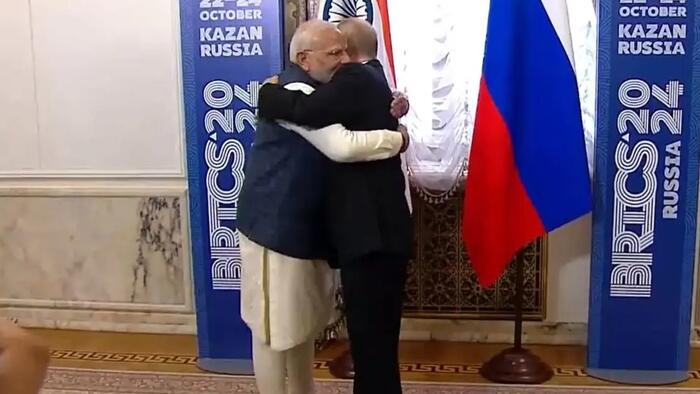The annual BRICS summit held in Kazan, Russia, began with Indian Prime Minister Narendra Modi advocating for a peaceful and swift resolution to the ongoing conflict in Ukraine during his meeting with Russian President Vladimir Putin. Modi emphasized the importance of settling disputes through dialogue and diplomatic means, reinforcing India’s commitment to restoring peace and stability in the region. This summit serves as a platform for Russia to showcase its significance on the global stage against a backdrop of Western pressure. Modi’s call for peace comes at a time when numerous global leaders are gathering in Russia, including notable figures like Chinese President Xi Jinping and Turkish President Recep Tayyip Erdogan, highlighting a united front among BRICS nations regarding the war.
In his remarks, Modi reflected on his frequent interactions with Russia, noting that his two visits in three months underscore a strong bilateral relationship. He mentioned that the recent annual summit in Moscow had augmented cooperation between India and Russia across various domains. This sentiment was echoed by Putin, who characterized the Russian-Indian partnership as a “particularly privileged strategic partnership.” Their discussions extended beyond the immediate conflict in Ukraine, encompassing a broader vision for BRICS as an influential coalition resisting Western dominance in global affairs.
The significance of the BRICS summit extends beyond discussions about the Ukraine war, as it symbolizes Russia’s efforts to project itself as a key player in global governance. By hosting the summit, Moscow aims to counter narratives presented by the West about its isolation in the international community. Supporters of the BRICS framework emphasize its role in providing an alternative platform for emerging economies, as well as addressing concerns about the Western-controlled financial system. Analysts suggest that the expansion of BRICS is indicative of shifting global power dynamics, where developing nations seek to fortify their economic and political positions.
One of the critical agenda items for the summit involves exploring payment systems designed to challenge the dominance of SWIFT, the established global international payment system. The current geopolitical climate, particularly surrounding the Ukraine conflict, has prompted countries to reconsider their reliance on Western financial infrastructures. By advancing a BRICS-led alternative, member states like Russia and China aim to enhance their economic sovereignty and create a more multi-polar financial landscape that reflects the realities of today’s global economy.
In addition to the pressing issue of Ukraine, the BRICS summit also addresses the escalating tensions in the Middle East. The conflict has intensified, particularly with the ongoing Israeli airstrikes targeting Iran in response to missile attacks. These regional conflicts are likely to be a focal point in the discussions among BRICS leaders, as member nations explore collaborative approaches to foster stability and peace in their respective regions. The summit thus provides an opportunity for collective diplomatic efforts to address not only Euro-Asian tensions but also broader middle-eastern crises.
Overall, the BRICS summit presents a multifaceted agenda that encompasses peace initiatives, economic reforms, and security challenges. The gathered leaders form a coalition that aims to illustrate the resilience of non-Western powers in the pursuit of a more balanced global order. With a clear intention to bolster cooperation and strengthen ties, the summit symbolizes the ambition of BRICS nations to redefine their roles in international relations while counteracting the hegemony traditionally held by Western powers. As developments unfold in Kazan, the future trajectory of BRICS will have significant implications for global political and economic dynamics.

